Ladenia better known as Greek Pizza in the U.S., is a delicious combination of ripe tomatoes, sliced onions, olives, and feta cheese on a fluffy freshly baked focaccia-style crust.

Many cultures have their version of “pizza,” from Turkish Pide to Manaqish to Lahmacun. This Greek pizza dish, known as Ladenia, originates from the Island of Kimolos in the Aegean Sea. It combines the Greek olive oil flatbread and the Italian thick-based focaccia pizza to create a delightful dish. So why not enjoy the best of both worlds?
Ladenia is named after the olive oil used to prepare and flavor it. The word “ladi” means oil—the star ingredient of this recipe. The best option is always extra virgin olive oil (stock up at our shop). The dough is soft and made with yeast, soaking in all the flavor and making a beautifully pillowy cushion for the toppings.
While eating Ladenia, I am often reminded of the flavors of papara. Greeks refer to this when soaking bread in the juices left at the bottom of a Greek salad bowl. There’s a no-waste philosophy when it comes to olive oil! This pizza is a delectable combination of olive oil-moistened crust with a burst of tomato and onion flavors in every bite!
Table of Contents
- Greek Pizza Ingredients
- How to Make Greek Pizza
- Ways to Mix it Up
- Let’s Talk Dough.
- Can You Use a Store-Bought Pizza Dough for Ladenia (Greek Pizza)?
- Tips for Making Greek-Style Pizza Dough
- Pizza Stone or Sheet Pan?
- What to Serve with Greek Pizza
- Leftovers and Storage
- More Mediterranean “Pizzas”
- Ladenia (Greek Pizza) Recipe
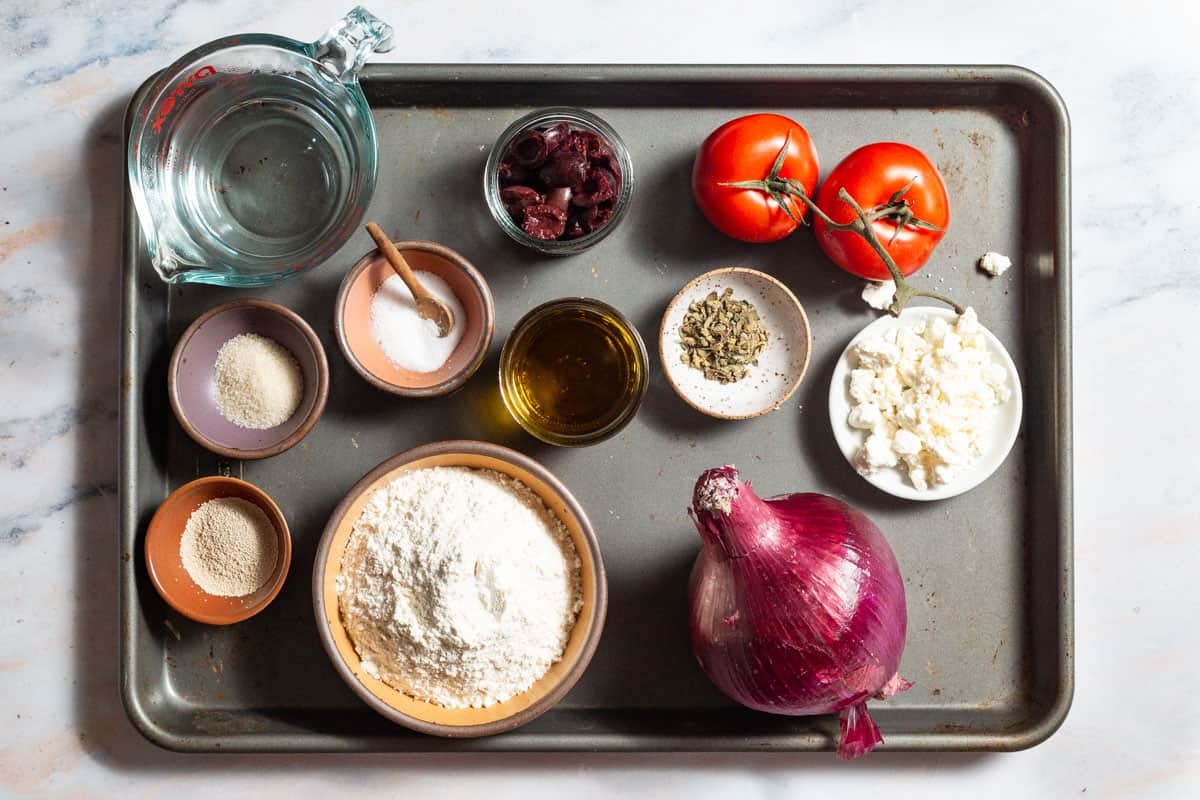
Greek Pizza Ingredients
In the traditional recipe, ladenia is topped with only tomato and onions. However, I like to add olives and feta cheese to enhance the flavors. As you can see it’s quite different from pizza commonly found in the U.S. with far less cheese and no tomato sauce. You’ll need:
For the Dough
- Yeast: I use instant yeast, which I rehydrate in a small amount of water and sugar. Active, rapid-rise, and instant yeast can be used interchangeably. However, using active yeast requires a little more time to rise.
- Castor (superfine) Sugar: Dissolves easily in the dough, adding flavor and helping to ferment the yeast. Sugar increases the dough’s moisture, weakening the gluten structure and helping to achieve an airier and softer texture. Without the addition of sugar the dough will take longer to rise.
- Flour: All-purpose flour is what I typically use as it has the right amount of protein and gives the right texture for a great base.
- Extra virgin olive oil: This is always my choice of oil, particularly Greek EVOO like our Early Harvest. It gives great flavor and richness.
For the Topping
- Tomatoes: As with a Greek salad, the tomatoes are the highlight of the topping for a Ladenia. Vine-ripened tomatoes that are soft and ripe are best. I prefer medium-sized Globe tomatoes, but you can use any variety you like. The riper and softer the tomatoes, the better. The tomato’s juices also add moisture and flavor to the dough while it cooks. I prefer to slice the tomatoes thinly, but slightly larger cuts also taste delicious.
- Onions: Thinly sliced red, white, or yellow onions add sharpness as well as depth. Red onions are sweeter and milder compared to white and yellow. The choice is yours.
- Oregano: I use dried Greek oregano for a flavor second to none. Oregano is both peppery and sharp and balances all the flavors.
- Feta Cheese: Adds a great sharpness.
- Olives: Pitted Kalamata olives add salty briney flavors that balance tomatoes’ acidity. Green olives could also be a great alternative.
- Salt: Enhances the flavors of the other ingredients.
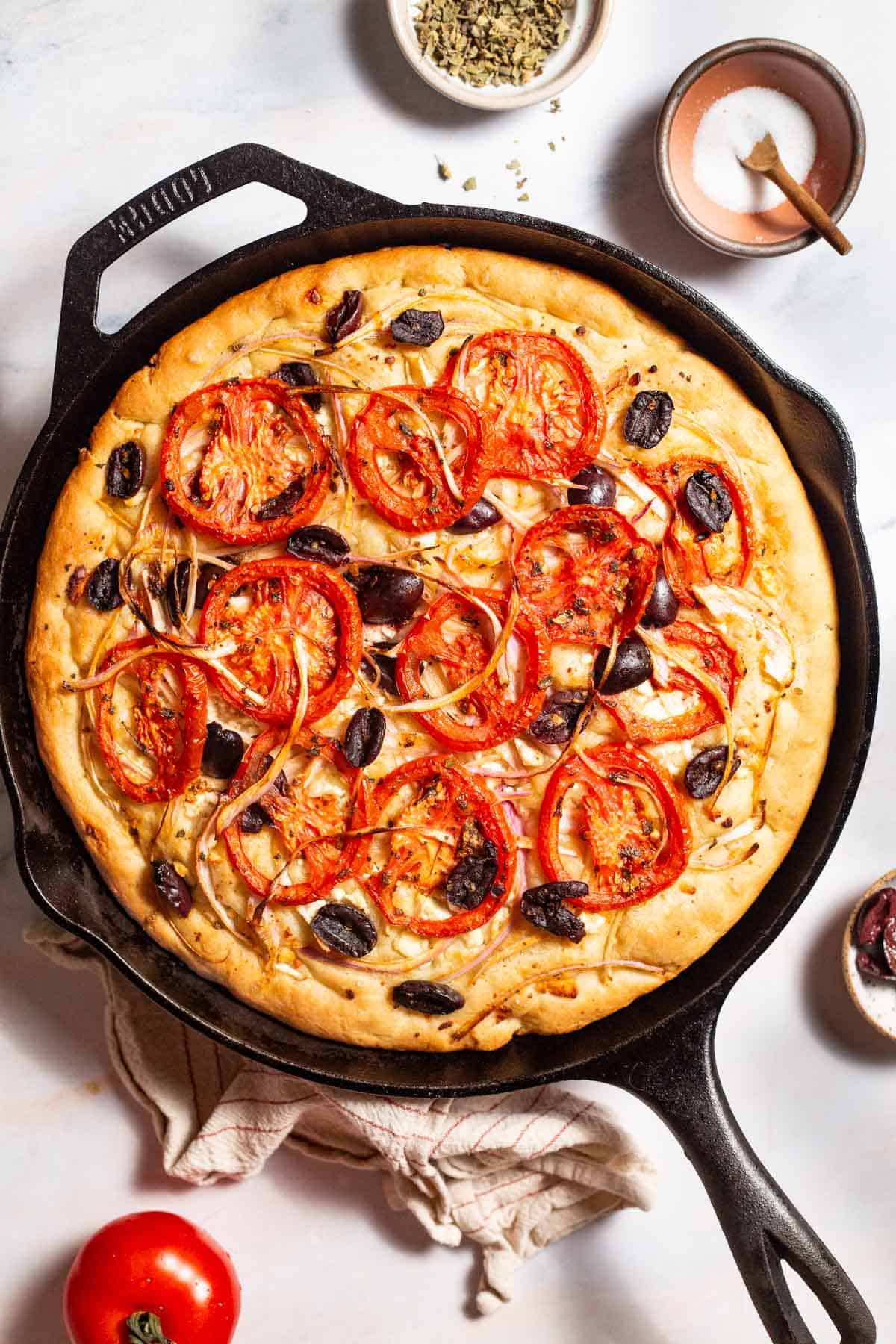
How to Make Greek Pizza
There’s nothing quite like homemade pizza and this recipe really is so simple. Consider it the starting place for all of your wonderful creativity! Here’s how you make it:
Make and Rest the Dough
- Activate the yeast. In a large bowl, gently whisk 1 tablespoon yeast, 1 teaspoon superfine sugar, and 1 1/2 cups lukewarm water until combined. Set aside until the yeast starts to bubble, at least 5 minutes.
- Make the dough. Add 2 1/2 cups all purpose flour, ¼ cup oil, and teaspoon of salt and mix the ingredients with a wooden spoon to form a soft, pliable dough.
- Stretch the dough. Grab a a round baking pan or 12-inch cast iron skillet with a minimum depth of 1 inch. Coat in a thin layer of olive oil. Transfer the dough to the skillet. Use your fingertip to gently indent the dough, jiggle, and stretch it to the edges of the skillet. (To see this technique visit our focaccia tutorial). It may keep bouncing back slightly. Gently keep dimpling the dough with your fingertips until it is as far to the edges as possible. Don’t worry too much if it does not stretch right to the ends; you will do it again after proofing.
- Proof the dough. Cover with a damp tea towel and allow it to rise for 30 minutes.
- Meanwhile, make the topping. Place 2 thinly sliced tomatoes, 1 thinly sliced red onion, 1 tablespoon dried oregano, 1/2 cup olive oil, and 1/2 cup sliced Kalamata olives into a bowl. Season with a bit of salt and mix to coat with the olive oil, being careful not to break up the tomatoes, and set aside.
Build and Bake
- Get ready to bake. Preheat your oven to 400°F. After 30 minutes, remove the tea towel and dimple the dough with your fingertips to make indentations and stretch the dough to the edges of the pan.
- Build and bake. Add 3 1/2 ounces crumbled feta cheese over the top of the dough, then spread the tomato mixture over the feta cheese, distributing it evenly. Spoon any accumulated juices from the tomatoes and olive oil over the top. Bake for 30–40 minutes, or until the crust is cooked and the top is golden.
- Serve. Remove from the oven, cut into pieces, and serve warm or at room temperature.
Ways to Mix it Up
You can tweak this recipe endlessly, varying the toppings to suit your taste. Here are my suggestions:
- Make it vegan: Just skip the cheese. Traditional ladenia is topped with just onions and tomatoes and is so delicious!
- Bell peppers: Add finely sliced red and green peppers to the tomato mix.
- Salami: If you prefer a meat pizza, you can add sliced salami on top of the feta.
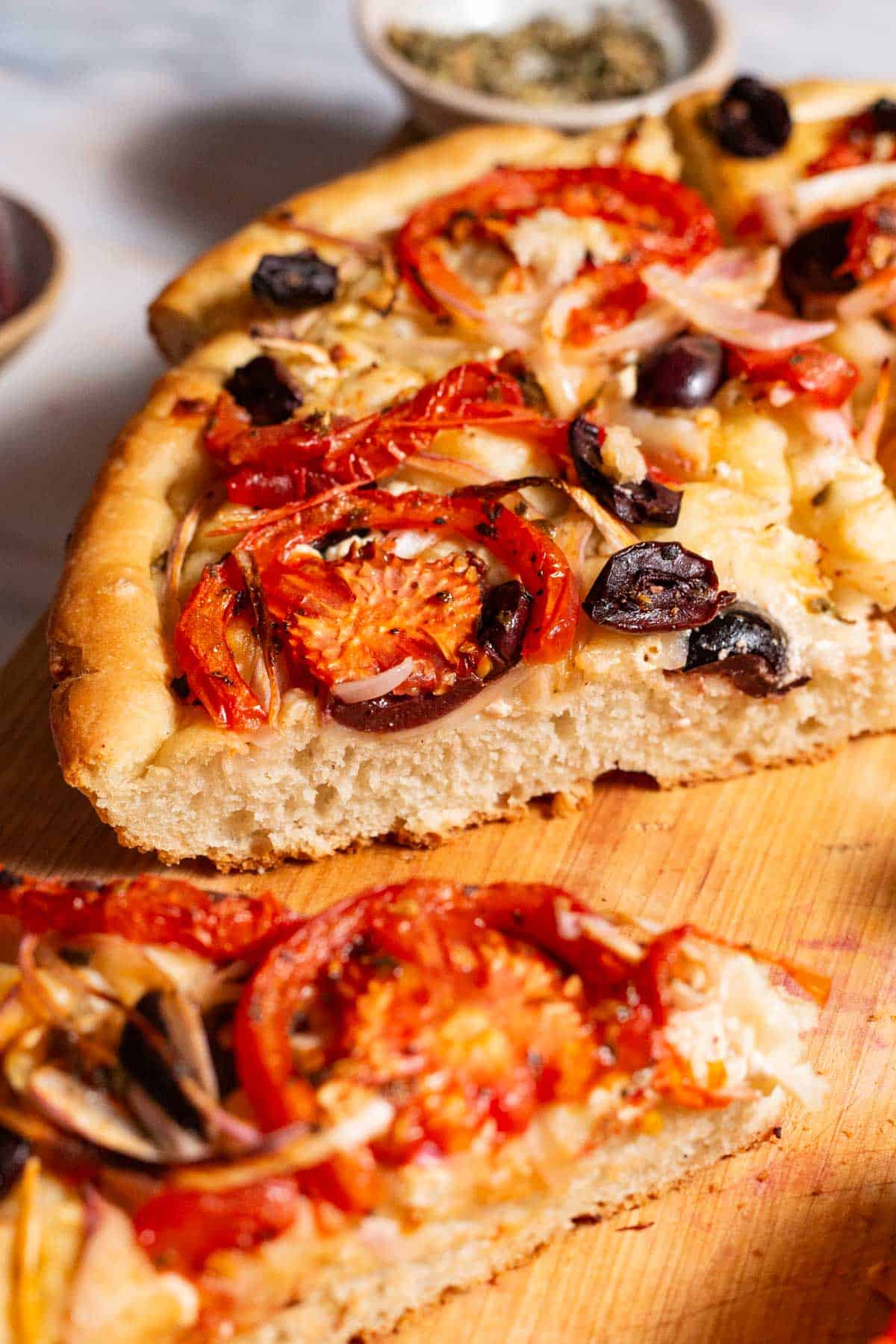
Let’s Talk Dough.
Everyone knows that a delicious pizza starts with great pizza dough. Some people like it thin and crispy, others thick and soft. This Greek pizza recipe has all these components. Here are some tips to get it right:
- If you bake the dish in a larger tray, it will turn out crispier and thinner.
- If you use the recommended 12-inch skillet or round pan it will be soft and perfectly capture the juices from the oil and tomatoes.
- Remember that the dough has a texture similar to a combination of focaccia and pizza dough.
- It comes together very quickly in one bowl, so no need to use a stand mixer.
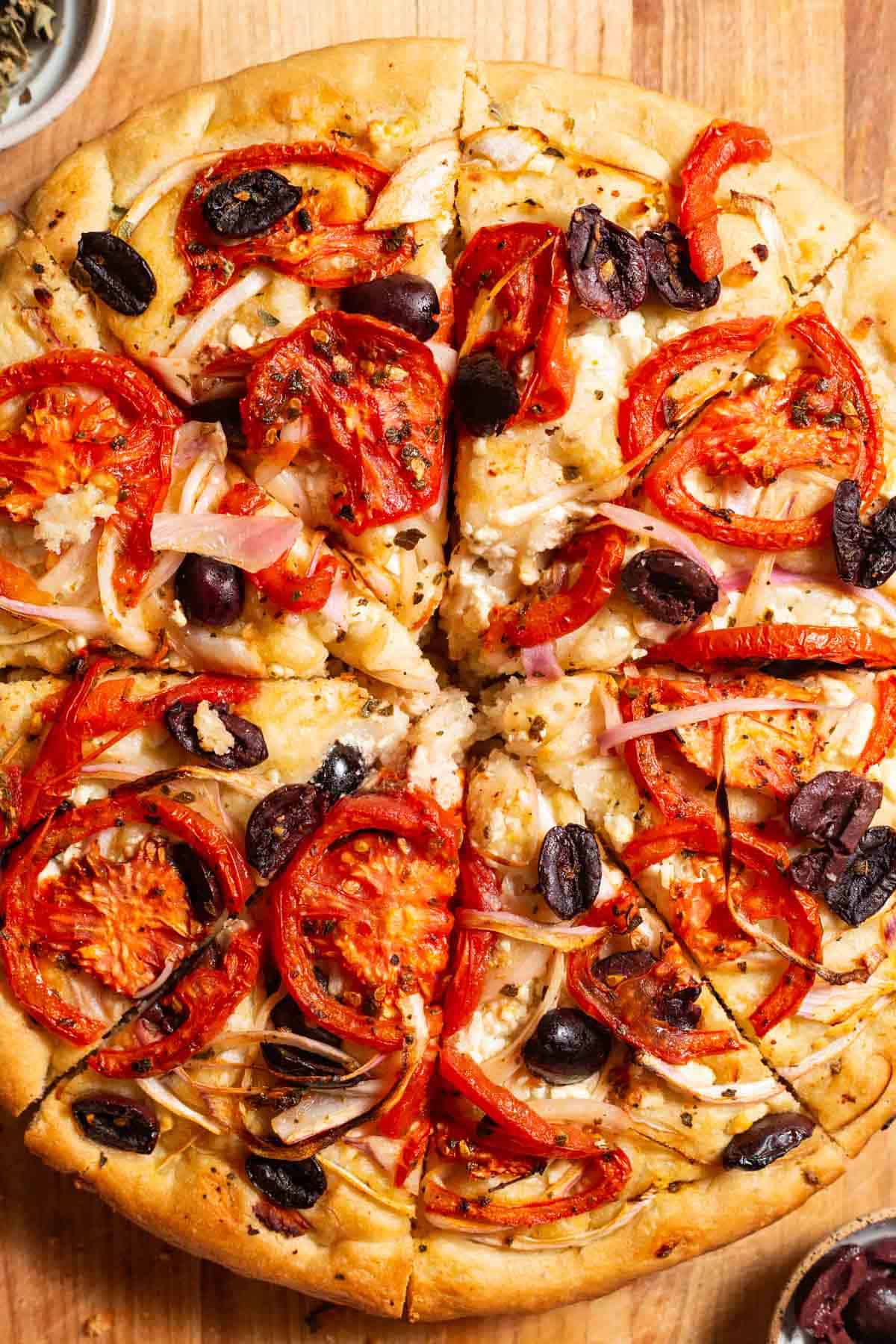
Can You Use a Store-Bought Pizza Dough for Ladenia (Greek Pizza)?
A store-bought pizza dough can work, but remember, this dough is slightly thicker and softer than a traditional pizza crust.
Many people are daunted by making yeasted doughs. While many good pizza dough brands are on the market, the taste, texture, and nutrition you get from making your own are second to none. It is so simple to make–so why not give it a go!
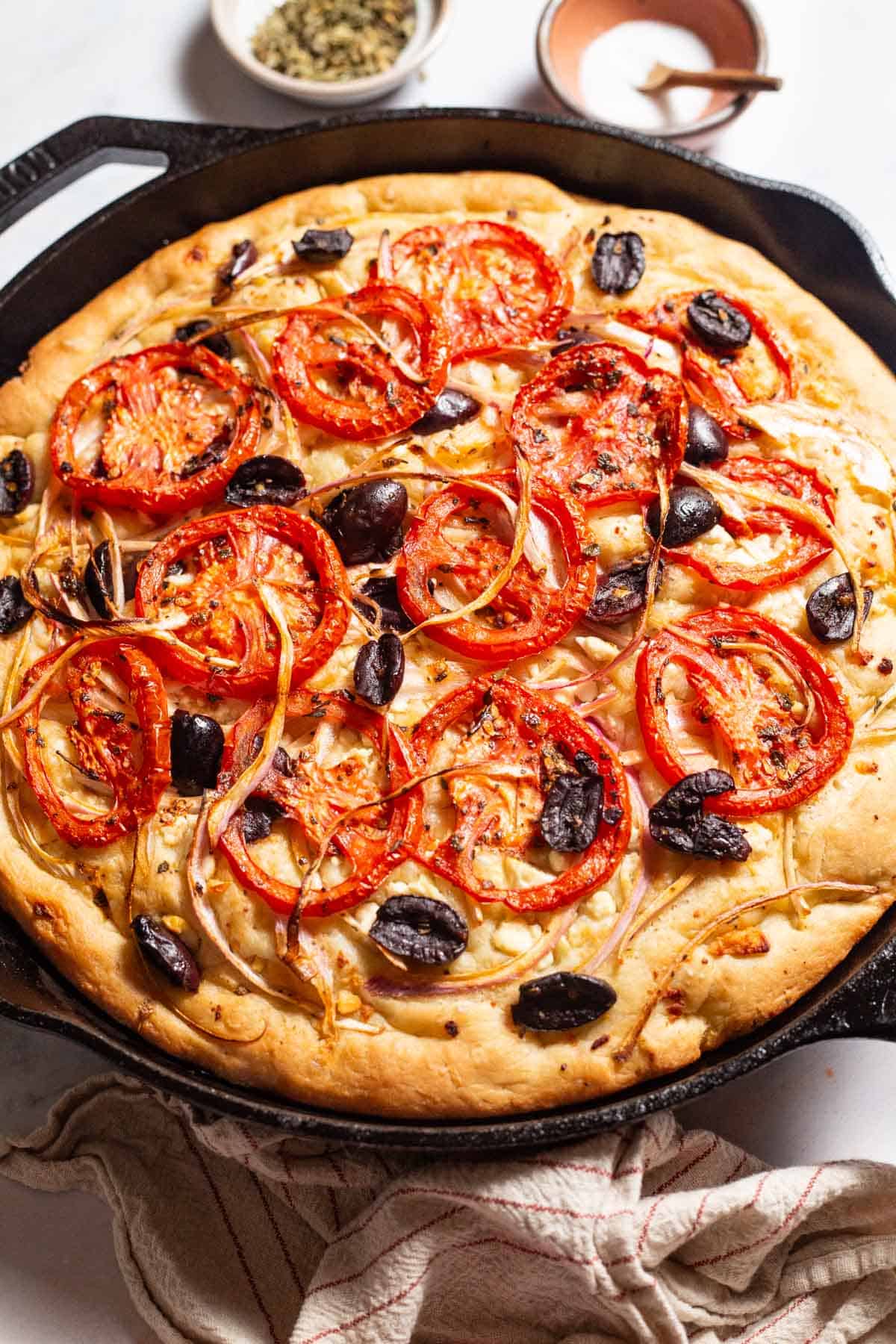
Tips for Making Greek-Style Pizza Dough
Flour
Choosing the correct flour is essential. I typically use all purpose white flour, but here are your other options for the dough:
- Unbleached all-purpose flour is great; however, remember that it has a slightly higher protein content. You won’t need to add as much water when making the dough.
- Bread flour will give you a crustier pizza. This works well.
- Whole wheat flour, though healthier, gives you a slightly harder overall texture. You could use half whole wheat flour and half all-purpose white flour.
- Gluten-free flour: To achieve the perfect rise and elasticity in the dough, opting for gluten-free flour may not be the best choice. Gluten plays a vital role in achieving these qualities, and removing it affects the result. Therefore, keep in mind that using gluten-free flour will not give you the same outcome as regular flour.
Yeast
Yeast ferments the natural sugars in the dough, releasing bubbles of carbon dioxide and giving the dough its light and airy texture. There are three main yeasts which are available.
- Instant Yeast is a hassle-free and convenient yeast, also known as rapid-rise yeast. It is not much different from active dry yeast. The main difference is that instant yeast has certain additives that help the yeast activate quickly and is ground slightly more finely. It can be rehydrated with water or sprinkled straight into a dough mixture.
- Active Dried Yeast is a dehydrated yeast. It has a long shelf life. It requires some water to rehydrate and activate. It can be used interchangeably with Instant Active Yeast.
- Fresh Yeast has a similar texture to clay and is sold in a solid block. It must be beige and have a pleasant smell to ensure freshness. Double the amount when using fresh yeast. It is highly perishable and must be used within two weeks of purchase.
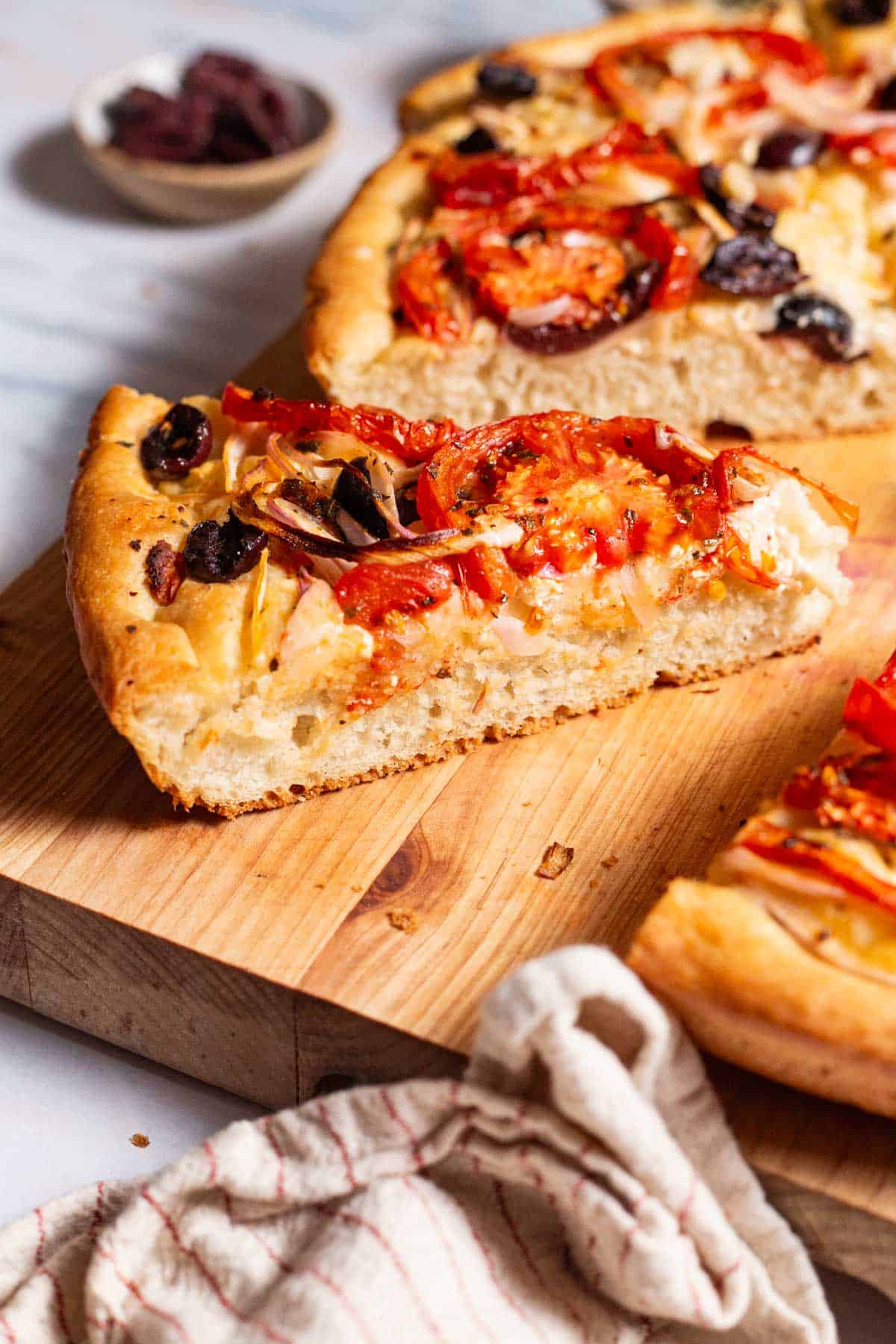
Pizza Stone or Sheet Pan?
To avoid any mess, I recommend using a cast iron skillet, round baking pan, or sheet pan with at least a 2-inch edge. The deeper the pan, the better it is, but it shouldn’t be less than 1 inch. This will prevent the oily juices from seeping over and causing a mess in the oven. Do not use a pizza tray with holes, a pizza stone, or a flat sheet pan without a rim.
What to Serve with Greek Pizza
This is a satisfying meal without any sides, but Big Easy Italian Salad would add a nice freshness. If you’d like something creamy and tangy for dipping, try Tzatziki.
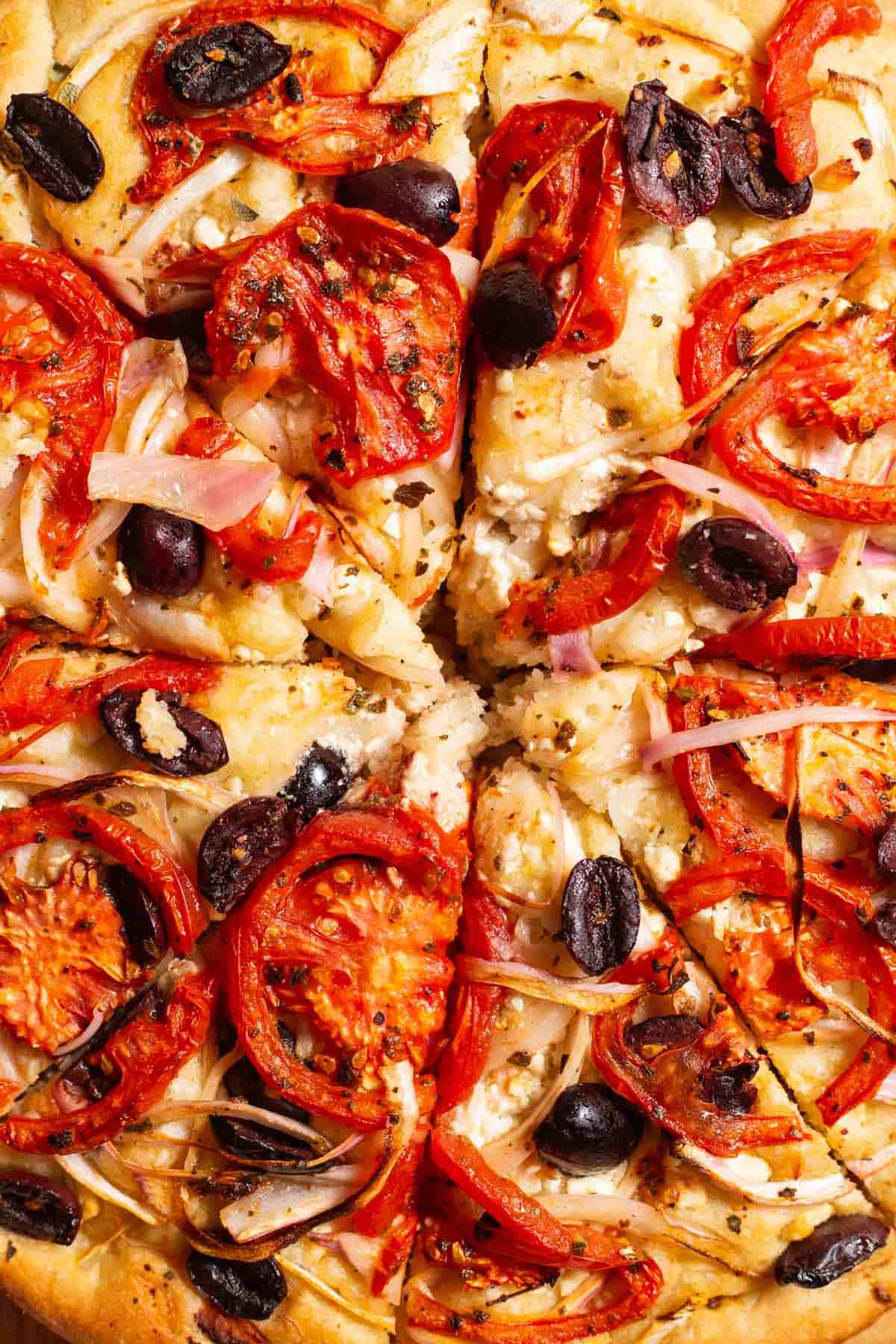
Leftovers and Storage
I don’t think you will have any leftovers! But in the unlikely case that you do, Greek pizza can be stored in an airtight container in the refrigerator for up to 2 days. Reheat in the oven or eat straight from the refrigerator. I am one for cold pizza!
More Mediterranean “Pizzas”
Browse All Mediterranean Recipes
Visit Our Shop
Bundle and Save!
Taste your way through the Mediterranean with our signature olive oil collection, including our famous Greek olive oils, Private Reserve, and Early Harvest, plus our new Nocellara Italian olive oil and Hojiblanca Spanish olive oil.

Ladenia (Greek Pizza)

Ingredients
For the Dough
- 1 tablespoon instant yeast
- 1 teaspoon castor (superfine) sugar
- 1 1/2 cups lukewarm water
- 2 1/2 cups (410 g) all-purpose flour
- 1/4 cup extra virgin olive oil, plus more for greasing the pan
- 1 teaspoon kosher salt
For the Topping
- 2 medium tomatoes, thinly sliced
- 1 medium red onion, thinly sliced
- 1 tablespoon oregano, ground in a mortar and pestle or spice grinder
- 1/2 cup extra virgin olive oil
- 1/2 cup Kalamata olives, pitted and sliced (optional)
- 3/4 cup (3 1/2 ounces) crumbled feta cheese (optional)
Instructions
- Make the dough. In a large bowl, gently whisk the yeast, sugar, and warm water until combined. Set aside until the yeast starts to bubble, at least 5 minutes. Add the flour, ¼ cup oil, and teaspoon of salt and mix the ingredients with a wooden spoon to form a soft, pliable dough. If the dough is too dry, add a little more water; if it is too wet, add a little flour.
- Stretch the dough. Coat a round baking pan, 11-inch in diameter with a minimum depth of 1 inch, in a thin layer of olive oil. Transfer the dough into the skillet and use your fingertips to gently press, jiggle, and stretch the dough to the edges of the skillet (like a focaccia). It may keep bouncing back slightly. Don't worry too much if it does not stretch to the edge of pan; you will stretch the dough again after proofing.
- Proof the dough. Cover the dough with a damp tea towel and allow it to rise for 30 minutes.
- Meanwhile, make the topping. Place the tomatoes, onion, dried oregano, ½ cup olive oil, and olives into a bowl. Season with a bit of salt and mix to coat with the olive oil, being careful not to break up the tomatoes, and set aside.
- Get ready to bake. Preheat your oven to 400°F. After 30 minutes, remove the tea towel. Use your fingertips to gently stretch and jiggle the dough toward the edge of pan. When finished the dough should have lots of dimples and indentations.
- Build and bake. Add the crumbled feta cheese over the top of the dough, then spread the tomato mixture over the feta cheese, distributing it evenly. Spoon any accumulated juices from the tomatoes and olive oil over top. Bake for 30–40 minutes, or until the base is cooked and the top is golden.
- Serve. Remove from the oven, cut into pieces, and serve warm or at room temperature.
Video
Notes
- Shop this recipe: Visit our shop to browse quality Mediterranean ingredients including the olive oils used in this recipe.
- Use a baking pan or sheet pan with at least a 1-inch deep edge. The deeper the pan, the better it is, but it should not be less than 2 inches. This will prevent the oily juices from seeping over and causing a mess in the oven. Do not use a pizza tray with holes, a pizza stone, or a flat sheet pan without a rim.
- Make it vegan: Just skip the cheese. Traditional ladenia is topped with just onions and tomatoes and is so delicious!
- Store in an airtight container in the refrigerator for up to 2 days. Reheat in the oven or eat straight from the refrigerator. Or enjoy cold!



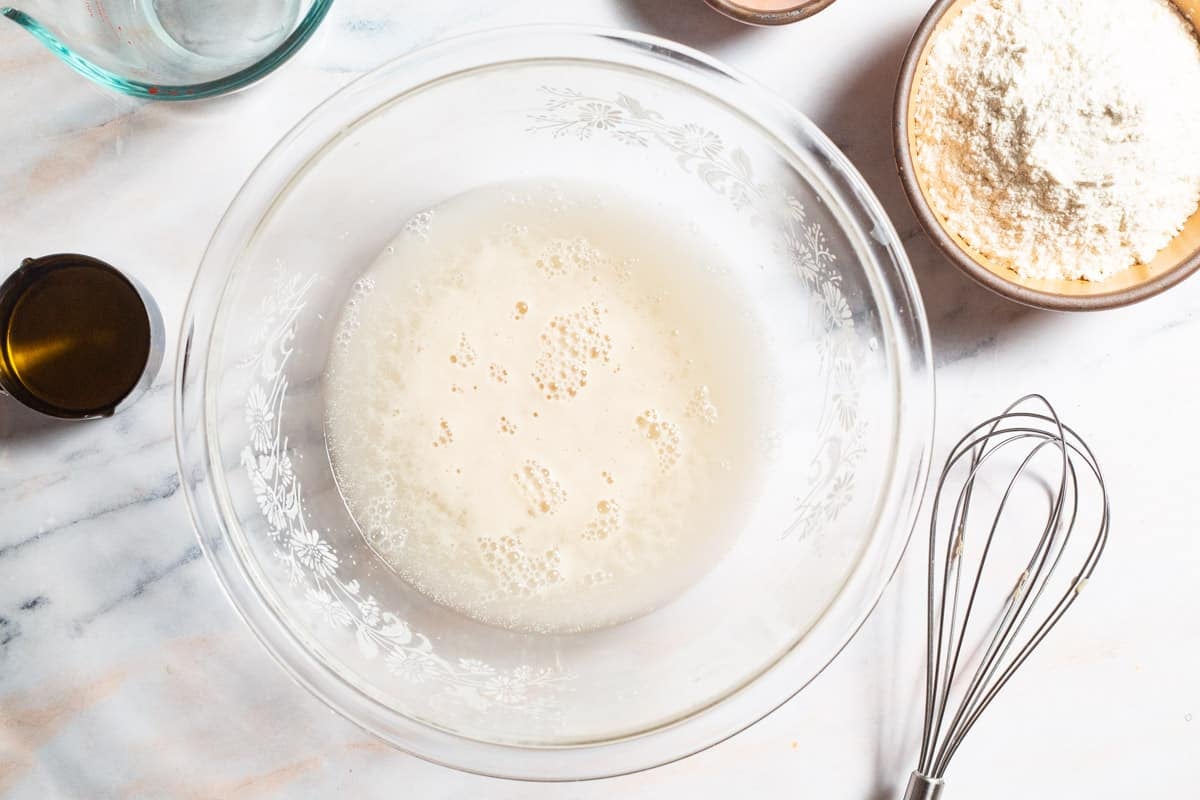
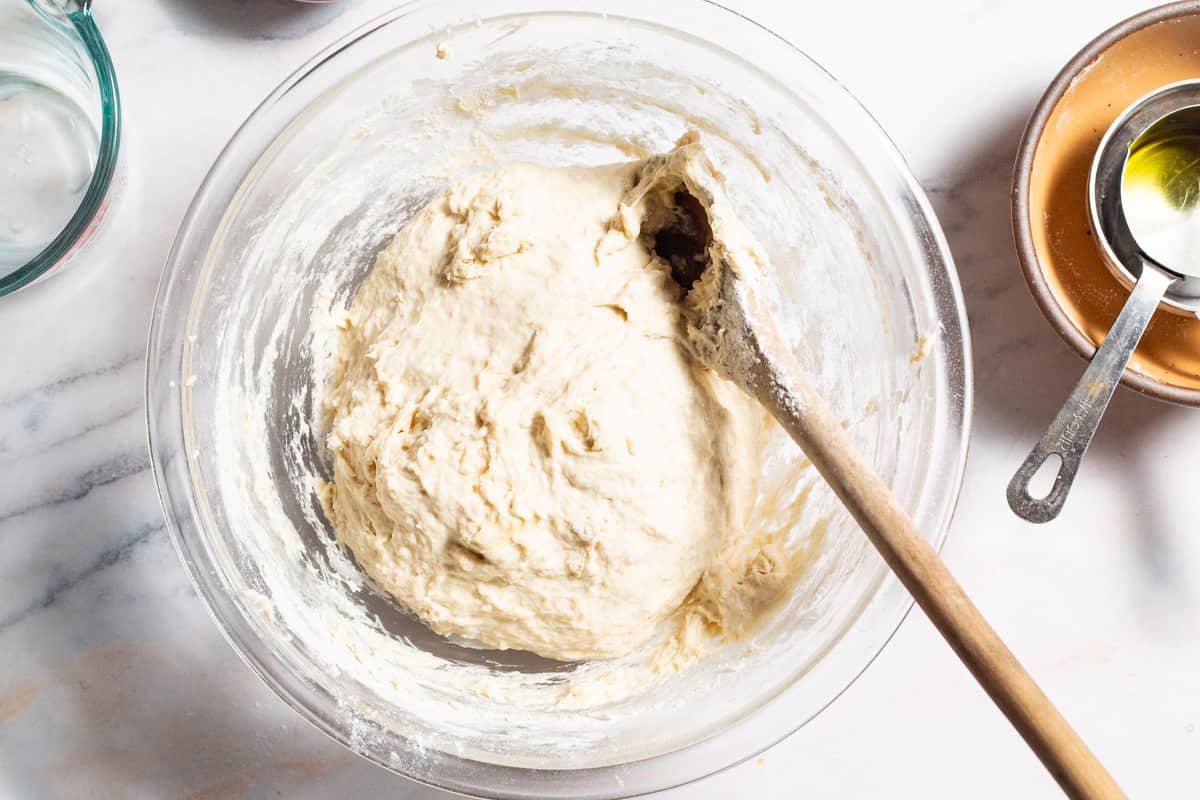
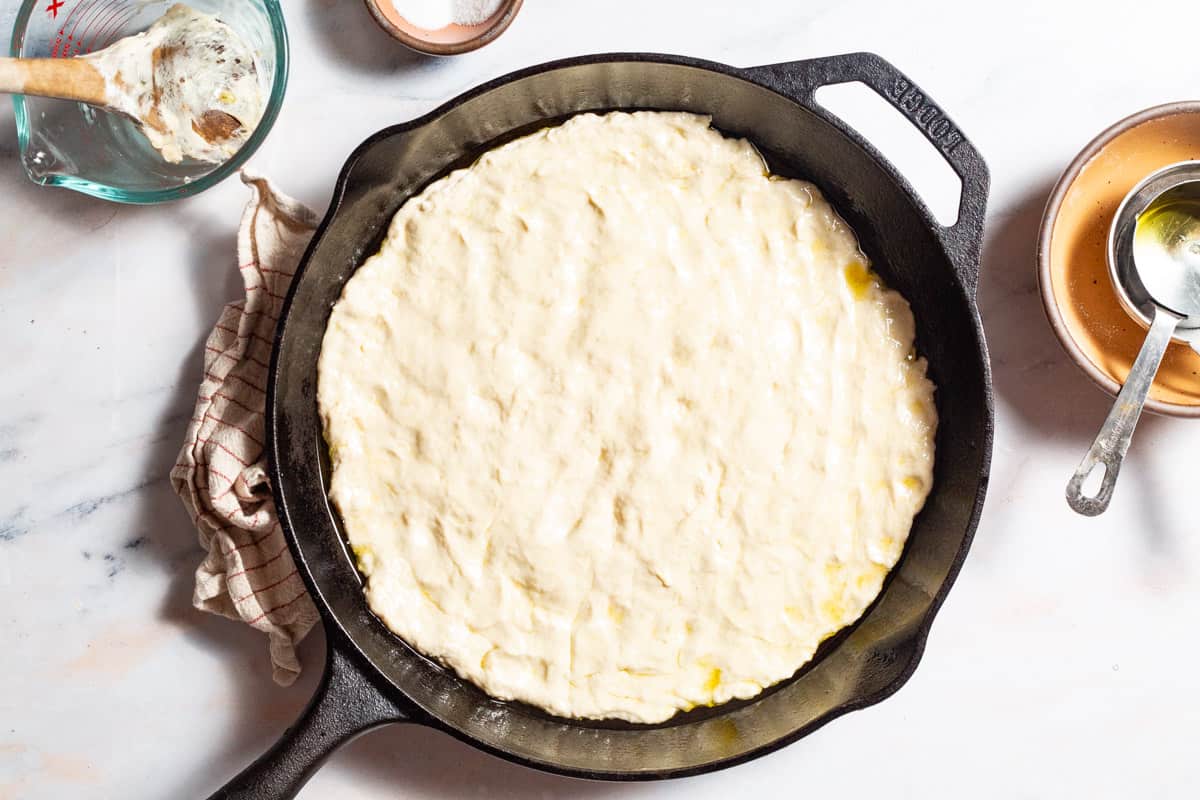
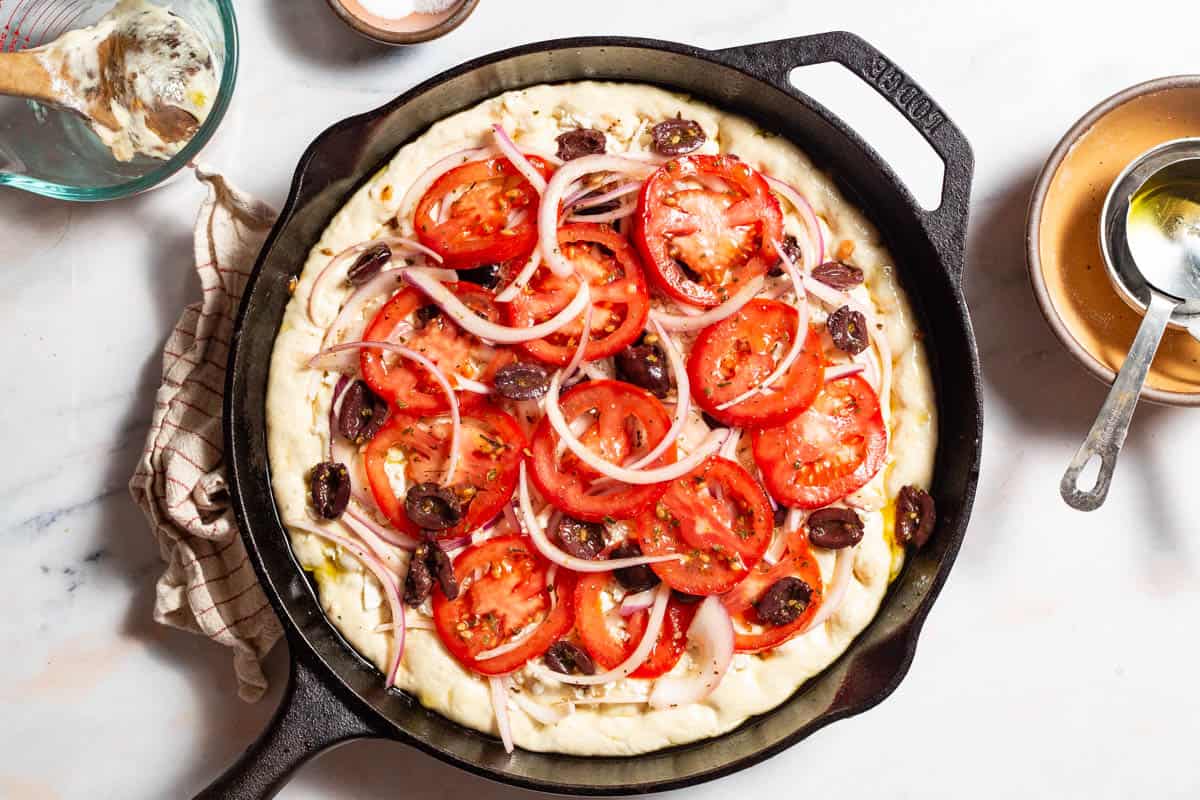
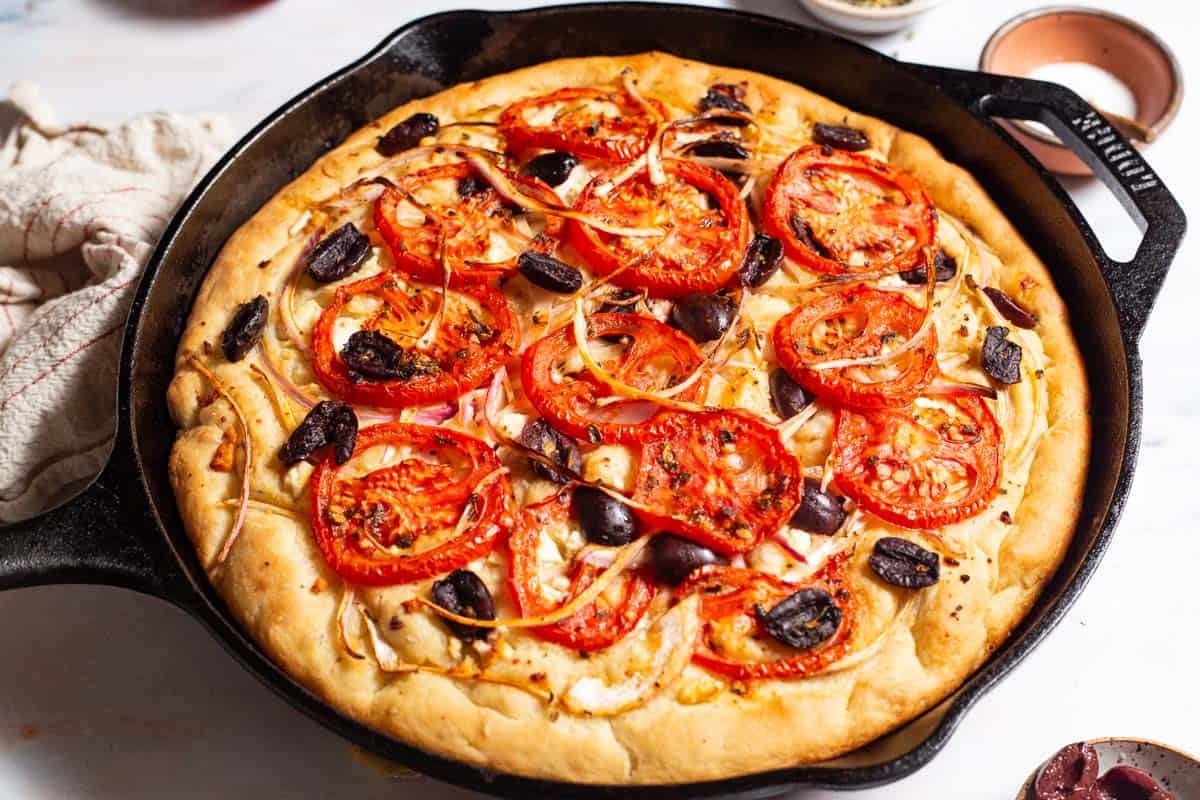
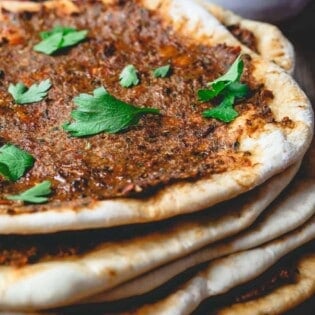


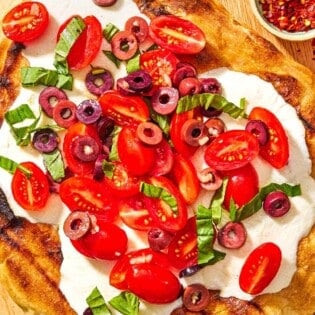
I was not at all sure what to expect but I am trying more “Mediterranean” recipes. This really surpassed my expectations, it was delicious. And even heated up well the next day.
So glad you enjoyed this one! Hope you continue on this adventure!!
This was amazing! I am a huge fan of thick crust pizza as well as foccacia bread and this wonderful melange of the two. My 10 1/2 in cast iron skillet worked perfect for us. I diced up a few sundried tomatoes which were packed in olive oil and also added some marinated artichokes on top. Wow!
It was very delicious!
Thank you, Robyn!
Another tasty dish from the Mediterranean Dish! My largest cake pan is 10″, which meant that the dough was very thick, maybe too thick. I’m going to try it on a rimmed backing sheet next time. The topping was tasty. I did add two sliced mushrooms and wish I had added lots of garlic. Next time!
I believe the measurements in this recipe are incorrect. It would take approx 2 cups of olive oil to fill a 12” pan with 1” of olive oil as called for in the recipe.
This means the recipe would call for about 3 cups of olive oil, if you include the 1/4 cup in the dough and 1/2 cup with the topping.
Hi Claire, Devin here from The Mediterranean Dish team. You’re totally right! This was meant to be a 1-inch deep pan that’s thinly coated in olive oil, not 1-inch worth of olive oil. I’ve updated this, thank you for taking the time to write in!
Rather confused about the amount of oil for the pan! The recipe specifies ‘Add olive oil so it’s 1-inch deep’ (twice!) but I measured (using water) in my 12 inch skillet, and that would be a pint of olive oil – the poor thing would be floating on it!! In the short for this recipe which Suzy has posted on YouTube, she clearly only pours in a couple of tablespoons and swooshes it about with a brush – nowhere near a pint!
Maybe this is why the portion size says ‘Serves 15’, even though the picture shows it cut into 8, to keep the calories per portion reasonable?
I’ve still given it five stars, as I know it will be fantastic, but I’ll be following the video for the oil in the pan, not the recipe!
Hi DeeDee, Devin here from the Mediterranean Dish team. Thank you very much for taking the time to write in – it is meant to be a 1-inch deep pan, not one inch of olive oil. We have updated this post with the correction. Thank you again!
The comment a bout using gluten free flour wasn’t very helpful! Those of us with gluten issues do not choose gluten free flour on a whim; I have celiac disease and follow a strict gluten-free diet. I look for recipes that make that choice work , not dismissive comments
I didn’t feel the comment re gluten free flour was dismissive at all – merely informative – basically, if you choose to try it, don’t be disappointed if you don’t get the same result.
I agree, Alimak. She was simply informing those who might try gluten-free flour and expect (not knowing) it to produce the same texture as regular flour. No need to be offended. This site is always great for being informative and helpful.